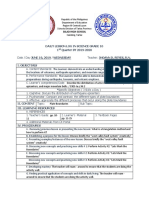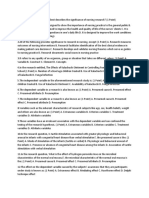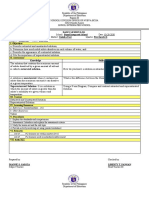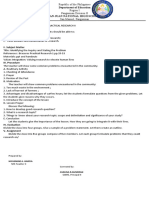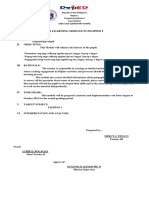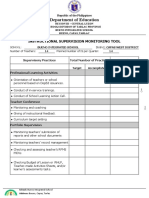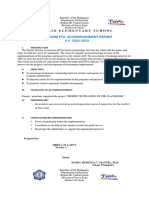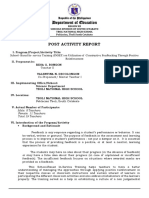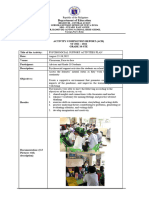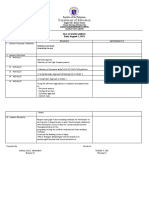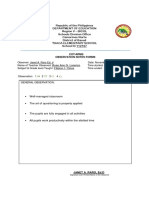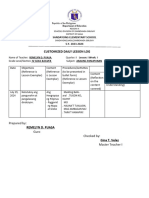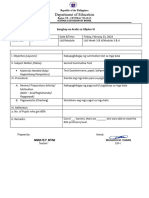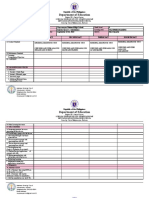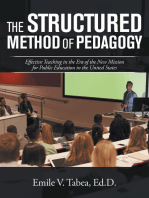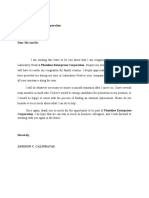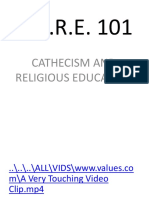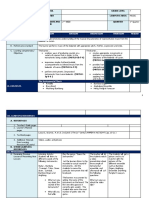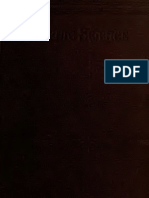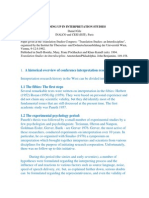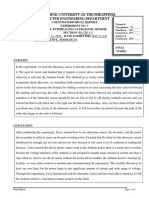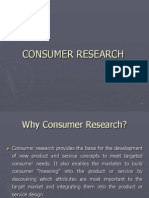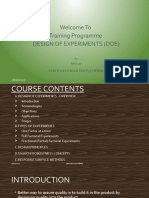0 ratings0% found this document useful (0 votes)
58 viewsDLL Science (Week1)
DLL Science (Week1)
Uploaded by
Dianne S. Garcia- The document is a daily lesson log from Bunol Integrated School in the Philippines detailing science lessons on the scientific method and forces for grades 7 and 8.
- The lessons aim to teach students to identify the steps of the scientific method, use it to solve problems through experiments, and relate it to daily life.
- They also aim to teach students about different types of forces including balanced and unbalanced forces and their effects on objects at rest or in motion.
- The logs document the lesson objectives, assessments, content, resources, and procedures to help ensure mastery of the concepts.
Copyright:
© All Rights Reserved
Available Formats
Download as DOCX, PDF, TXT or read online from Scribd
DLL Science (Week1)
DLL Science (Week1)
Uploaded by
Dianne S. Garcia0 ratings0% found this document useful (0 votes)
58 views5 pages- The document is a daily lesson log from Bunol Integrated School in the Philippines detailing science lessons on the scientific method and forces for grades 7 and 8.
- The lessons aim to teach students to identify the steps of the scientific method, use it to solve problems through experiments, and relate it to daily life.
- They also aim to teach students about different types of forces including balanced and unbalanced forces and their effects on objects at rest or in motion.
- The logs document the lesson objectives, assessments, content, resources, and procedures to help ensure mastery of the concepts.
Original Description:
hgfd
Original Title
DLL SCIENCE (WEEK1)
Copyright
© © All Rights Reserved
Available Formats
DOCX, PDF, TXT or read online from Scribd
Share this document
Did you find this document useful?
Is this content inappropriate?
- The document is a daily lesson log from Bunol Integrated School in the Philippines detailing science lessons on the scientific method and forces for grades 7 and 8.
- The lessons aim to teach students to identify the steps of the scientific method, use it to solve problems through experiments, and relate it to daily life.
- They also aim to teach students about different types of forces including balanced and unbalanced forces and their effects on objects at rest or in motion.
- The logs document the lesson objectives, assessments, content, resources, and procedures to help ensure mastery of the concepts.
Copyright:
© All Rights Reserved
Available Formats
Download as DOCX, PDF, TXT or read online from Scribd
Download as docx, pdf, or txt
0 ratings0% found this document useful (0 votes)
58 views5 pagesDLL Science (Week1)
DLL Science (Week1)
Uploaded by
Dianne S. Garcia- The document is a daily lesson log from Bunol Integrated School in the Philippines detailing science lessons on the scientific method and forces for grades 7 and 8.
- The lessons aim to teach students to identify the steps of the scientific method, use it to solve problems through experiments, and relate it to daily life.
- They also aim to teach students about different types of forces including balanced and unbalanced forces and their effects on objects at rest or in motion.
- The logs document the lesson objectives, assessments, content, resources, and procedures to help ensure mastery of the concepts.
Copyright:
© All Rights Reserved
Available Formats
Download as DOCX, PDF, TXT or read online from Scribd
Download as docx, pdf, or txt
You are on page 1of 5
Republic of the Philippines
Department of Education
Region III
SCHOOLS DIVISION OFFICE OF NUEVA ECIJA
SDO-Guimba Annex
BUNOL INTEGRATED SCHOOL
DAILY LESSON LOG
Name of Teacher: DIANNE S. GARCIA School: Bunol Integrated School Date: 10-07-2020
Grade: 7 Section: Rizal District: Guimba East Quarter: First (week 1)
Subject: SCIENCE Time: 9:30-11:30
I. Objectives
a. Identify the steps of a scientific method;
b. Use the scientific method in solving problem through an experiment; and
c. Relate scientific method in daily life.
II. Assessment
Knowledge Skills
1. Scientific method- It is the process by which science 1. Identify the six basic steps of Scientific Method.
is carried out, as in other areas of inquiry.
2. . Identifying and controlling variables involve the 2. Understand and explain what is Identifying variables and controlling variables.
process of deciding which variables or factors will
influence the outcome of an experiment, situation or
event and deliberately control all recognized variables
in a systematic manner.
3. Variables in an experiment may be independent or 3. Give the difference between Dependent and Independent variables.
dependent.
III. Content
Scientific Method
Identifying and Controlling Variables, Variables(Dependent and Independent)
IV. Learning Resources
a. References: (books/modules…etc)
b. Other Resources:
Videos
V. Procedures
1. Explain the standards and competencies.
2. Assessment: Introduce and explain the assessment criteria.
3. Study the lesson set and the sub topic
4. Provide activity involving set using printed worksheet
VI. Remarks
___ out of ____ (%) learners are within mastery level
___ out of ____ (%) learners need remediation/reinforcement
VII. Reflection
Prepared by: Checked by:
DIANNE S. GARCIA LIBERTY T. PANGAN
Subject Teacher Head Teacher III
Republic of the Philippines
Department of Education
Region III
SCHOOLS DIVISION OFFICE OF NUEVA ECIJA
SDO-Guimba Annex
BUNOL INTEGRATED SCHOOL
DAILY LESSON LOG
Name of Teacher: DIANNE S. GARCIA School: Bunol Integrated School Date: 10-06-2020
Grade: 7 Section: AGUINALDO District: Guimba East Quarter: First (week 1)
Subject: SCIENCE Time: 1:30-3:30
I. Objectives
a. Identify the steps of a scientific method;
b. Use the scientific method in solving problem through an experiment; and
c. Relate scientific method in daily life.
II. Assessment
Knowledge Skills
1. Scientific method- It is the process by which science 1. Identify the six basic steps of Scientific Method.
is carried out, as in other areas of inquiry.
2. . Identifying and controlling variables involve the 2. Understand and explain what is Identifying and controlling variables.
process of deciding which variables or factors will
influence the outcome of an experiment, situation or
event and deliberately control all recognized variables
in a systematic manner.
3. Variables in an experiment may be independent or 3. Give the difference between Dependent and Independent variables.
dependent.
III. Content
Scientific Method
Identifying and Controlling Variables, Variables(Dependent and Independent)
IV. Learning Resources
a. References: (books/modules…etc)
b. Other Resources:
Videos
V. Procedures
1. Explain the standards and competencies.
2. Assessment: Introduce and explain the assessment criteria.
3. Study the lesson set and the sub topic
4. Provide activity involving set using printed worksheet
VI. Remarks
___ out of ____ (%) learners are within mastery level
___ out of ____ (%) learners need remediation/reinforcement
VII. Reflection
Prepared by: Checked by:
DIANNE S. GARCIA LIBERTY T. PANGAN
Subject Teacher Head Teacher III
Republic of the Philippines
Department of Education
Region III
SCHOOLS DIVISION OFFICE OF NUEVA ECIJA
SDO-Guimba Annex
BUNOL INTEGRATED SCHOOL
DAILY LESSON LOG
Name of Teacher: DIANNE S. GARCIA School: Bunol Integrated School Date: 10-07-2020
Grade: 8 Section: Archimedes District: Guimba East Quarter: First (Week 1)
Subject: SCIENCE Time: 9:30-11:30
I. Objectives
a. Identify what forces are acting on an object at rest.
b. Examine the situations when the forces are balanced; and
c. Explain the effect of unbalanced forces on the state of motion of an object.
II. Assessment
Knowledge Skills
Force can be operationally Investigate the relationship between the amount of force applied
defined based on observed effects. and the mass of the object to the amount of change in the object’s motion.
This means
that a force can be described in
terms of what it does.
Forces that are equal in magnitude Explain the effect of balanced forces on the state of motion of an object
but opposite in direction are called
balanced forces.
Forces that cause a change in the Explain the effect of unbalanced forces on the state of motion of an object.
motion of an object are
unbalanced forces.
Contact forces – forces where Differentiate the difference between Contact and Non-Contact Forces.
objects touch or contact with each
other.
Non-contact forces – forces
where objects do not touch or
contact with each other.
These forces act over a zone or
area called field.
III. Content
Force
Balanced forces, Unbalanced
Contact forces, Non-contact forces
IV. Learning Resources
a. References: (books/modules…etc)
b. Other Resources:
Videos
V. Procedures
1. Explain the standards and competencies.
2. Assessment: Introduce and explain the assessment criteria.
3. Study the lesson set and the sub topic
4. Provide activity involving set using printed worksheet
VI. Remarks
___ out of ____ (%) learners are within mastery level
___ out of ____ (%) learners need remediation/reinforcement
VII. Reflection
Prepared by: Checked by:
DIANNE S. GARCIA LIBERTY T. PANGAN
Subject Teacher Head Teacher III
Republic of the Philippines
Department of Education
Region III
SCHOOLS DIVISION OFFICE OF NUEVA ECIJA
SDO-Guimba Annex
BUNOL INTEGRATED SCHOOL
DAILY LESSON LOG
Name of Teacher: DIANNE S. GARCIA School: Bunol Integrated School Date: 10-05-2020
Grade: 8 Section: EUCLID District: Guimba East Quarter: First (Week 1)
Subject: SCIENCE Time: 9:30-11:30
I. Objectives
a. Identify what forces are acting on an object at rest.
b. Examine the situations when the forces are balanced; and
c. Explain the effect of unbalanced forces on the state of motion of an object.
II. Assessment
Knowledge Skills
Force can be operationally Investigate the relationship between the amount of force applied
defined based on observed effects. and the mass of the object to the amount of change in the object’s motion.
This means
that a force can be described in
terms of what it does.
Forces that are equal in magnitude Explain the effect of balanced forces on the state of motion of an object
but opposite in direction are called
balanced forces.
Forces that cause a change in the Explain the effect of unbalanced forces on the state of motion of an object.
motion of an object are
unbalanced forces.
Contact forces – forces where Differentiate the difference between Contact and Non-Contact Forces.
objects touch or contact with each
other.
Non-contact forces – forces
where objects do not touch or
contact with each other.
These forces act over a zone or
area called field.
III. Content
Force
Balanced forces, Unbalanced
Contact forces, Non-contact forces
IV. Learning Resources
a. References: (books/modules…etc)
b. Other Resources:
Videos
V. Procedures
1. Explain the standards and competencies.
2. Assessment: Introduce and explain the assessment criteria.
3. Study the lesson set and the sub topic
4. Provide activity involving set using printed worksheet
VI. Remarks
___ out of ____ (%) learners are within mastery level
___ out of ____ (%) learners need remediation/reinforcement
VII. Reflection
Prepared by: Checked by:
DIANNE S. GARCIA LIBERTY T. PANGAN
Subject Teacher Head Teacher III
Republic of the Philippines
Department of Education
Region III
SCHOOLS DIVISION OFFICE OF NUEVA ECIJA
SDO-Guimba Annex
BUNOL INTEGRATED SCHOOL
DAILY LESSON LOG
Name of Teacher: DIANNE S. GARCIA School: Bunol Integrated School Date: 10-08-2020
Grade: 9 Section: ARISTOTLE District: Guimba East Quarter: First (week 1)
Subject: SCIENCE Time: 1:00-3:00
I. Objectives
a. Identify the parts of the respiratory and circulatory systems;
b. Describe the functions of each part of the respiratory and circulatory systems;
c. Explain how the respiratory and circulatory systems work together.
II. Assessment
Knowledge Skills
Respiratory system is composed of organs that help us
breathe air in and out – supplying oxygen and Describe the functions of the parts of Respiratory System.
eliminating carbon dioxide gases.
Circulatory system, also known as
cardiovascular/vascular system, transports nutrients, Identifying the parts of the circulatory system and describe their functions.
respiratory gases, and metabolic products throughout a
living organism which permits integration among the
various tissues.
The breathing is a process that allows the movement Trace the path of air during inhalation and exhalation.
of air in and out of the lungs.
Pulmonary circulation transports blood between the
heart and the lungs. Describe pulmonary and systemic circulations.
Systemic circulation moves blood between the heart
and the rest of the body.
III. Content
Respiratory and Circulatory System
Pulmonary and Systematic Circulation
The Mechanics of Breathing
IV. Learning Resources
a. References: (books/modules…etc)
b. Other Resources:
Videos
V. Procedures
1. Explain the standards and competencies.
2. Assessment: Introduce and explain the assessment criteria.
3. Study the lesson set and the sub topic
4. Provide activity involving set using printed worksheet
VI. Remarks
___ out of ____ (%) learners are within mastery level
___ out of ____ (%) learners need remediation/reinforcement
VII. Reflection
Prepared by: Checked by:
DIANNE S. GARCIA LIBERTY T. PANGAN
Subject Teacher Head Teacher III
You might also like
- Key To Correction in PRACTICAL RESEARCH 2Document5 pagesKey To Correction in PRACTICAL RESEARCH 2leandrojigz0188% (105)
- Science: Quarter 2 - Module 3: Understanding TyphoonDocument24 pagesScience: Quarter 2 - Module 3: Understanding TyphoonDianne S. Garcia100% (10)
- Science 10 DLLDocument2 pagesScience 10 DLLjohann reyes86% (7)
- Accomplishment Report SampleDocument11 pagesAccomplishment Report SampleEduardoAlejoZamoraJr.90% (21)
- Detailed Lesson Plan in MAPEH 7 MusicDocument9 pagesDetailed Lesson Plan in MAPEH 7 MusicDianne S. GarciaNo ratings yet
- Nursing Research Exam SampleDocument9 pagesNursing Research Exam SampleMarlchiel Nathan ArregladoNo ratings yet
- DLL Science (Week 4)Document5 pagesDLL Science (Week 4)Dianne S. GarciaNo ratings yet
- DLL Science (Week 6)Document5 pagesDLL Science (Week 6)Dianne S. GarciaNo ratings yet
- DLL Science (Week 7)Document5 pagesDLL Science (Week 7)Dianne S. GarciaNo ratings yet
- DLL Science (Week 5)Document5 pagesDLL Science (Week 5)Dianne S. GarciaNo ratings yet
- Accomplishment Reports in Classroom and CoordinatorshipDocument6 pagesAccomplishment Reports in Classroom and Coordinatorshipangie.kikoNo ratings yet
- Slac 9 8 2022Document7 pagesSlac 9 8 2022daisy fortinNo ratings yet
- Lesson Plann ResearchDocument1 pageLesson Plann ResearchHiyasmine GarciaNo ratings yet
- DLL Handicraft - Grade 7 q2w10Document3 pagesDLL Handicraft - Grade 7 q2w10lawsinmaureenNo ratings yet
- Cot 2 Sci 6 - BDocument10 pagesCot 2 Sci 6 - BKuya JM's ToyNo ratings yet
- Deped Format LPDocument3 pagesDeped Format LPjonabel.sevillanaNo ratings yet
- lesson-log-LAWS OF MOTIONDocument2 pageslesson-log-LAWS OF MOTIONAIRISH JOAN GATUSNo ratings yet
- Cot 3 Mapeh5 - BDocument10 pagesCot 3 Mapeh5 - BKuya JM's ToyNo ratings yet
- A Learning Module in Filipino IDocument2 pagesA Learning Module in Filipino IRica Mae TingcoNo ratings yet
- Instruction Monitoring ToolsDocument9 pagesInstruction Monitoring ToolsJOBEL CAPUNFUERZANo ratings yet
- Annual Accomplishment Report 2018Document7 pagesAnnual Accomplishment Report 2018Abigail de GuzmanNo ratings yet
- Psychosocial DLLDocument3 pagesPsychosocial DLLRio OrpianoNo ratings yet
- DLL CoDocument16 pagesDLL Corichardesguerra28No ratings yet
- Cot 2 Fili - BDocument11 pagesCot 2 Fili - BKuya JM's ToyNo ratings yet
- LPbhengkaDocument7 pagesLPbhengkacjoehanalynNo ratings yet
- Modified DLPDocument2 pagesModified DLPMarielle CrisostomoNo ratings yet
- Scie DLL q2 m6 CARBON COMPOUNDSDocument3 pagesScie DLL q2 m6 CARBON COMPOUNDSRoxanne Alcaide OrdoñezNo ratings yet
- Las3.1 Field-Testing Semi-Detailed-Lesson-Plan Dorcasmadrigal FVRNHSDocument6 pagesLas3.1 Field-Testing Semi-Detailed-Lesson-Plan Dorcasmadrigal FVRNHSlabanlangalaksan5445No ratings yet
- WLP Sample SHSDocument4 pagesWLP Sample SHSKrislyn Joy MalbataanNo ratings yet
- Q2W1 Filipino2Document2 pagesQ2W1 Filipino2Jennifer Modina SupranesNo ratings yet
- Pta Accomplishment ReportDocument2 pagesPta Accomplishment ReportShiela Maglanque100% (1)
- Lesson Plan - Pajarillo-Florin - (Day2)Document6 pagesLesson Plan - Pajarillo-Florin - (Day2)florinpajarillo13No ratings yet
- DLP TemplateDocument5 pagesDLP TemplateKate BatacNo ratings yet
- Annual Accomplishment Report: Maligaya National High SchoolDocument2 pagesAnnual Accomplishment Report: Maligaya National High SchoolGiancarla Ma. DingleNo ratings yet
- Accomplishment Report SampleDocument10 pagesAccomplishment Report SampleMelissa De LeonNo ratings yet
- Department of Education: Learning Delivery Modalities Course (LDM2)Document6 pagesDepartment of Education: Learning Delivery Modalities Course (LDM2)darwinNo ratings yet
- Post Test FeedbackingDocument7 pagesPost Test FeedbackingJaneNo ratings yet
- Learning Application PlanDocument1 pageLearning Application PlanAL Jeff Puguon100% (1)
- EXAM (Monday & Tuesday)Document2 pagesEXAM (Monday & Tuesday)Maria Angela EduardoNo ratings yet
- Cot DLL - ScienceDocument2 pagesCot DLL - Sciencekristel guanzonNo ratings yet
- Q2W1 Filipino2Document2 pagesQ2W1 Filipino2Jennifer Modina SupranesNo ratings yet
- Cesc - DLL - Q2 - Week 1Document8 pagesCesc - DLL - Q2 - Week 1Edmar S. DimaanoNo ratings yet
- Elln Acr 2024Document2 pagesElln Acr 2024Ara Faye BaldevaronaNo ratings yet
- ACR PsychosocialDocument5 pagesACR PsychosocialHar FloresNo ratings yet
- NLC Lesson GuideDocument3 pagesNLC Lesson GuideAnnaliza Dawal Manabat100% (1)
- May 9Document4 pagesMay 9JONALYN NGAPPOLNo ratings yet
- PPST Rpms Forms 2018 2019Document8 pagesPPST Rpms Forms 2018 2019CATHERINE LABARONo ratings yet
- Accomplishment Sir EduardDocument10 pagesAccomplishment Sir EduardEduardoAlejoZamoraJr.No ratings yet
- Periodic Accomplishment ReportDocument3 pagesPeriodic Accomplishment ReportCHRISTIAN EANo ratings yet
- 2023 UCSP DLL Nov. 3 17 2023 - 1Document4 pages2023 UCSP DLL Nov. 3 17 2023 - 1peterpaul.aquino12No ratings yet
- Training ProposalDocument2 pagesTraining ProposalJennifer TabaqueNo ratings yet
- Intervention Grade 3 GKDocument6 pagesIntervention Grade 3 GKjaycynNo ratings yet
- PREANDPOSDocument3 pagesPREANDPOSKimberly VillanuevaNo ratings yet
- DLL Stat 6th Week For COT FinalDocument3 pagesDLL Stat 6th Week For COT FinalJessa May Marcos100% (1)
- Hope 2-G11Document11 pagesHope 2-G11Aprille RamosNo ratings yet
- DLL 7 CookeryDocument4 pagesDLL 7 CookeryRodolfo CubangbangNo ratings yet
- CDLL q1 WK 1 ArpanDocument5 pagesCDLL q1 WK 1 ArpanpuasaremelynNo ratings yet
- Banghay Na Aralin Sa Filipino VIDocument2 pagesBanghay Na Aralin Sa Filipino VIMaria Fe IntinaNo ratings yet
- DLL 1st Quarter Week 4Document3 pagesDLL 1st Quarter Week 4Kareen GerminianoNo ratings yet
- Lesson Plan (Bandaging)Document1 pageLesson Plan (Bandaging)Marianne Joy Lodo AguinaldoNo ratings yet
- GRADE 8 DLL Apr 24-28, 2023Document2 pagesGRADE 8 DLL Apr 24-28, 2023Teacher Tin CabanayanNo ratings yet
- The Structured Method of Pedagogy: Effective Teaching in the Era of the New Mission for Public Education in the United StatesFrom EverandThe Structured Method of Pedagogy: Effective Teaching in the Era of the New Mission for Public Education in the United StatesNo ratings yet
- To study the effect of rural and urban backgrounds on teachers' self-efficacy and personality factorsFrom EverandTo study the effect of rural and urban backgrounds on teachers' self-efficacy and personality factorsNo ratings yet
- The Myth of Ability: Nurturing Mathematical Talent in Every ChildFrom EverandThe Myth of Ability: Nurturing Mathematical Talent in Every ChildRating: 3.5 out of 5 stars3.5/5 (3)
- Science7 Q2 M7 v2Document27 pagesScience7 Q2 M7 v2Dianne S. GarciaNo ratings yet
- School ID Region VIII Division Nueva Ecija District Guimba School Name Bunol Integrated School School Year 2019-2020 8 Section WisdomDocument11 pagesSchool ID Region VIII Division Nueva Ecija District Guimba School Name Bunol Integrated School School Year 2019-2020 8 Section WisdomDianne S. GarciaNo ratings yet
- March 15, 2020 Photoline Enterprises Corporation Vista Mall BataanDocument1 pageMarch 15, 2020 Photoline Enterprises Corporation Vista Mall BataanDianne S. GarciaNo ratings yet
- Our Lady of The Sacred Heart College of Guimba, Inc.: Guimba, Nueva Ecija, PhilippinesDocument5 pagesOur Lady of The Sacred Heart College of Guimba, Inc.: Guimba, Nueva Ecija, PhilippinesDianne S. GarciaNo ratings yet
- Report On Attendance: Sf9-Jhs de C Jan Feb Ma R Apr TotalDocument3 pagesReport On Attendance: Sf9-Jhs de C Jan Feb Ma R Apr TotalDianne S. GarciaNo ratings yet
- C.A.R.E. 101: Cathecism and Religious EducationDocument46 pagesC.A.R.E. 101: Cathecism and Religious EducationDianne S. GarciaNo ratings yet
- At The End of This Lesson, The Students or Learners Should Be Able ToDocument6 pagesAt The End of This Lesson, The Students or Learners Should Be Able ToDianne S. GarciaNo ratings yet
- Smea Data Gathering Template Enhanced 1Document92 pagesSmea Data Gathering Template Enhanced 1Dianne S. GarciaNo ratings yet
- q1 Grade 7 Pe DLL Week 2Document9 pagesq1 Grade 7 Pe DLL Week 2Dianne S. Garcia67% (3)
- DLL Music 7Document6 pagesDLL Music 7An Tho Nee100% (1)
- Anger Management Program Proposal Program Title: RationaleDocument4 pagesAnger Management Program Proposal Program Title: RationaleDianne S. GarciaNo ratings yet
- Matrix of Field Study 6: Subject Title Domain Competencies Units Professional Education SubjectDocument34 pagesMatrix of Field Study 6: Subject Title Domain Competencies Units Professional Education SubjectDianne S. GarciaNo ratings yet
- Science CultureDocument12 pagesScience CultureIrma AhkdirNo ratings yet
- Self Experimentation PaperDocument61 pagesSelf Experimentation Papercraig1014No ratings yet
- Boirac - Psychic ScienceDocument392 pagesBoirac - Psychic Sciencehummingbird_hexapla100% (2)
- Bio IA TemplateDocument4 pagesBio IA Templateeidmclsk100% (2)
- Project ReportDocument75 pagesProject ReportPankaj ThakurNo ratings yet
- Applied Social MethodsDocument681 pagesApplied Social Methodstoxicalfreak100% (2)
- Effectiveness of Mnemonics On Achievement of Students in Mathematics at Highschool LevelDocument4 pagesEffectiveness of Mnemonics On Achievement of Students in Mathematics at Highschool LevelIJMERNo ratings yet
- Gile (1994)Document10 pagesGile (1994)Iván Villanueva JordánNo ratings yet
- S4R Template JavelinDocument1 pageS4R Template JavelinFikriyah YayuNo ratings yet
- Scientific Method Unit Test: Answer KeyDocument1 pageScientific Method Unit Test: Answer KeyZara RejusoNo ratings yet
- Gia Application Format FP PDFDocument6 pagesGia Application Format FP PDFrks_rmrctNo ratings yet
- How To Think About The Astrology Research Program: An Essay Considering Emergent EffectsDocument12 pagesHow To Think About The Astrology Research Program: An Essay Considering Emergent EffectsTreeSapNo ratings yet
- Research Reviewer 1Document6 pagesResearch Reviewer 1CRISTOBAL, JAMAINE R.No ratings yet
- Rasa or A "Blank Slate"?Document21 pagesRasa or A "Blank Slate"?bkb8jNo ratings yet
- Accounting Textbook Solutions - 1Document19 pagesAccounting Textbook Solutions - 1acc-expertNo ratings yet
- Gce 103Document48 pagesGce 103bigboysgang2019No ratings yet
- PDF Notes BST Xii (2024) Ch-1Document56 pagesPDF Notes BST Xii (2024) Ch-1Manya KambojNo ratings yet
- The Manipulator A Psychoanalytic View PDFDocument542 pagesThe Manipulator A Psychoanalytic View PDFSanja Kastratović100% (2)
- Customer SatisfactionDocument75 pagesCustomer Satisfactionujranchaman0% (1)
- Food AdulterationDocument17 pagesFood AdulterationAvnish BhasinNo ratings yet
- A Tutorial For Information Theory in NeuroscienceDocument40 pagesA Tutorial For Information Theory in Neurosciencepaul mNo ratings yet
- Lesson Plan TemplateDocument3 pagesLesson Plan Templateapi-250429044No ratings yet
- Polytechnic University of The Philippines: Computer Engineering DepartmentDocument2 pagesPolytechnic University of The Philippines: Computer Engineering DepartmentnikkiNo ratings yet
- Mothers's Knowledge and Behavior of Anemia Prevention in Children: Application of Pender's Health Promotion Model - SICH 2020Document12 pagesMothers's Knowledge and Behavior of Anemia Prevention in Children: Application of Pender's Health Promotion Model - SICH 2020Dwie Anjani SaiNo ratings yet
- Experimental MethodsDocument27 pagesExperimental MethodsHAIQA SHOAIB DINARNo ratings yet
- Lab 1. Ubiquity of Bacteria and Hand WashingDocument2 pagesLab 1. Ubiquity of Bacteria and Hand WashingJessica FigasNo ratings yet
- Consumer ResearchDocument24 pagesConsumer ResearchShafeer KhanNo ratings yet
- DOE - PresentationDocument59 pagesDOE - PresentationRaajha MunibathiranNo ratings yet


